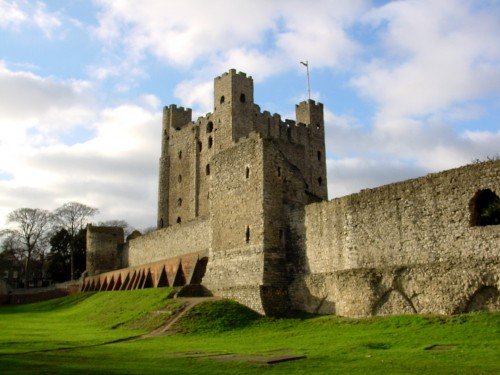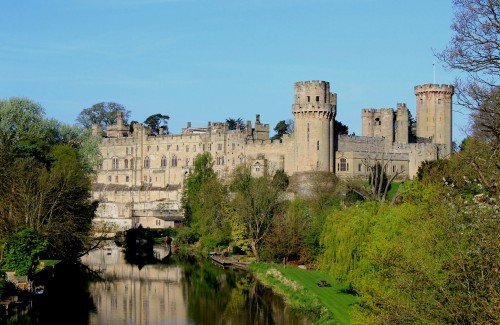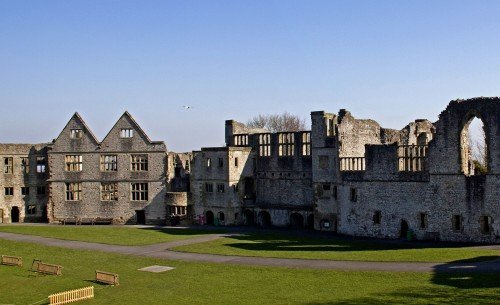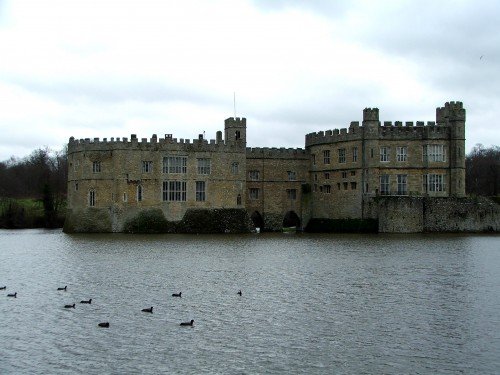Bodiam Castle – East Sussex

The picturesque ruins of Bodiam Castle are an opulent reminder of its medieval splendor. It was built in 1385 as a defense against invasion from the French, and existed quietly until it was partly demolished during the Civil War. Rising from the surrounding grassy fields and the tranquil waters of its moat, the castle appears like something from a medieval fairytale, complete with rustic weathered ivy-clad walls, battlements, towers and windows that stare like vacant eyes over the countryside. Reports from people passing the ruins at night have described hearing the sounds of phantom carousing, including strange songs and raucous outbursts. A ghostly red lady has also been seen gazing blankly into the distance from one of the towers, though her identity is unknown. Even the castle’s alluring reflection on the dark waters of the moat appears like a ghostly apparition of the castle itself.
Rochester Castle – Kent

A scorned suitor, a damsel in distress, and two vicious sieges form part of Rochester Castle’s turbulent history. Built in the early 12th century by William de Corbeil, Archbishop of Canterbury, this formidable fortress has one of England’s largest keeps. Political strife and a desire to avenge unrequited love resulted in its capture by the spurned suitor Sir Gilbert de Clare, who cunningly seized the castle and the Lady Blanche de Warrene who hid inside. She was tragically killed by her betrothed Sir Ralph de Capo when he fired an arrow meant to kill de Clare and save her from his grasp. Ever since that night, her ghost has been seen roaming the battlements with the arrow still lodged in her chest. She strikes a melancholic figure with her flowing white gown and her dark hair cascading in the night.
Warwick Castle – Warwickshire

The stunning ruins of Warwick Castle have been witness to murder, political intrigues and power struggles. At one time King Edward IV was held captive here by Richard Neville, Earl of Warwick, while the deposed Henry VI was confined in the Tower of London. Warwick Castle is also reputedly where orders were given for the heinous murder of the two young princes Edward and Richard who died in the Tower of London. But the ghost who haunts this indefatigable bastion of power is Sir Fulke Greville who lived in the castle during the early part of the 17th century. It is said that he was stabbed by his servant in a moment of resentment and jealousy. The wounded Greville died a month later in agonizing pain. The specter of his forlorn spirt has been glimpsed in dark corners of his former study in the castle where stares in gloomy sadness.
Dudley Castle – West Midlands

The primary ghostly occupant of the romantic ruins of Dudley Castle is the Gray Lady who is believed to be a woman named Dorothy Beaumont whose baby had died before her. The bereaved Gray Lady’s wraith has been seen wandering the castle in search of her infant child. Other spirits too have been sighted lingering amongst the medieval remnants of this fortified structure, including the ghost of an elderly lady who took her own life by hanging herself from the castle’s parapet. These and other mysterious figures seem to roam the castle and its grounds which now form part of the Dudley Zoological Gardens that opened in 1937. Although sections of the curtained wall, gatehouse and keep were destroyed on orders of Parliament during the Civil War in 1646, and the castle was encompassed by fire the following century, its romantic ruins and long history continue to draw many visitors.
Leeds Castle – Kent

Leeds Castle is arguably one of England’s most gorgeous castles. This beautiful bastion is called the “castle of the medieval Queens of England” because it has been home to numerous royal wives. Originally built in the 13th century, the castle grew larger as additions were made throughout the centuries by its succeeding owners. Its most discernible otherworldly occupant is a black dog whose apparition is said to have resulted when Eleanor of Gloucester, Henry VI’s aunt, was imprisoned for life at Leeds Castle after being charged with witchcraft, black magic, treason and heresy. The dog’s appearances were a bad omen foretelling misfortune or death for the castle’s inhabitants. The spectral hound has continued to haunt the castle property since about the 15th century.
Author: Jocelyn Murray
Hi! I am a robot. I just upvoted you! I found similar content that readers might be interested in:
http://www.totsandtravel.com/2014/10/14762/5-haunted-castles-of-england/